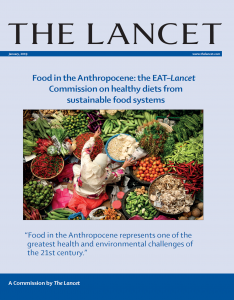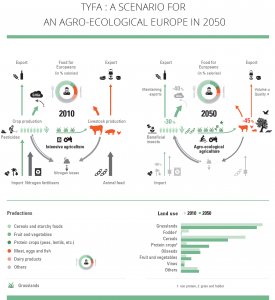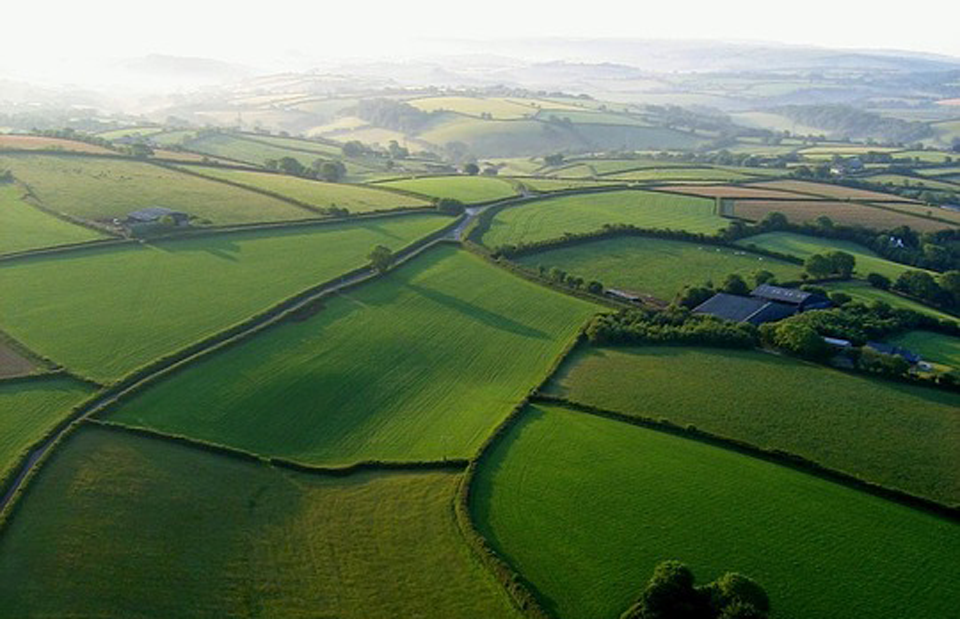The European sustainable development think-tank IDDRI has a 10 year plan to get the continent on a track towards sustainable agriculture, while producing ample food to provide a healthy diet to 530 million Europeans.
Their fascinating new report is entitled “An agroecological Europe in 2050: multifunctional agriculture for healthy eating. Findings from the Ten Years For Agroecology (TYFA) modelling exercise.” It applies a comprehensive, quantitative methodology to take a hard look at what a sustainable food system would look like for Europe.
The IDDRI’s key contribution is laying out in some detail a credible, concrete path that Europe can follow over the decade or so, bringing about profoundly transformational change but at a manageable, incremental pace.
Success will depend on three things, according to IDDRI.
First, a commitment to refine, promote, and reward adoption of agro-ecological systems. Second, cutting daily consumption of animal products — and especially feedlot and CAFO meat, poultry, and diary — by about 40%. Third, shifting caloric intake toward raw or lightly processed, plant-based foods, and cutting food waste. According to IDDRI, these changes will collectively deliver:
- An impressive suite of health benefits for people and animals,
- A much cleaner and more species-diverse and rich environment, and
- Thousands of new jobs, enterprises, and career paths, while improving the share of the food dollar that stays on the farm.
Positive contributions to local food culture and enjoyment of regional cuisines, enhancing the vitality of rural communities, and help in combating global climate change are icing on the cake.
The authors define agroecology as “an innovation pathway in agricultural systems aimed at maximising the use of ecological processes in the functioning of agro-ecosystems, with a view to achieving sustainable food” (Poux and Aubert, 2019).
Compared to today’s pesticide and fertilizer-intensive farming systems, agroecology depends heavily on careful management of local and territorial nutrient flows and crop-pest interactions. An essential ingredient is diversifying the mix of crops grown, to take fuller advantage of the entire growing season. It is also important to more astutely match livestock enterprises and the crops and forages growing on land to:
- The productive capacity of soils,
- An area’s climate, and
- What local and regional markets are willing to buy at a price leaving farmers an adequate return to cover not just annual production costs, but also sustain long-term investments in soil health and environmental quality.
Through diversification and thoughtful sequencing of crops, many of today’s most costly pest problems can be largely eliminated, or at least reduced enough to avoid the need for routine, disruptive, high-impact pesticide applications. Reducing broad-spectrum insecticide use is especially essential, in light of recent science reporting that insecticides are a primary factor threatening extinction of some 40% of the insect species on earth.
So-called agro-ecosystems “make maximum use of soil life and legume symbiotic nitrogen fixation capacities” by phasing out synthetic fertilizers that inhibit this critical, natural source of nitrogen.
This, along with the use of “unfertilised natural grasslands” as nitrogen sources and refuges for pollinators and other wildlife “makes it possible to directly address the restoration of biodiversity, the quality of natural resources and a reduction in greenhouse gas emissions” (Poux and Aubert, 2019).

But IDDRI also warns that widespread adoption of agroecology will come at a cost. The report projects yield reductions of around 10-50%, depending on the crop. The authors make the case that these yield losses aren’t an insurmountable issue, especially if Europeans adopt the “Planetary Health Diet” (see our reporting on this here) recently proposed by The EAT-Lancet Commission.
(See our accompanying blog “Embracing Change for Good Causes — Reflections on a Provocative IDDRI Report” for more on whether the reduction in yields foreseen by IDDRI are likely to persist, or fade as farmers gain experience with, and fine-tune agroecological farming systems adapted to place and farm types.)
The EAT-Lancet commission is a international coalition of food security and nutrition experts taking a hard look at “Food in the Anthropocene,” or as they call it “one of the greatest health and environmental challenges of the 21st century” (Willett et al., 2019).
This Planetary Health Diet entails eating less meat – around 40% less – and lowering sugar intake. It is higher in fiber and seasonal fruits and vegetables, and will result in a significant reduction in chronic, diet-related illnesses like heart disease, diabetes, and obesity.
As The Guardian reports in their piece about the IDDRI report, a shift away from animal products also helps eliminate “food-feed competition.” In Europe, over half of the total cereal and oilseed harvest is used to produce animal feed. Additional animal feed is imported from South America, fueling conversion of tropical rainforests and savannah to GE corn and soybean production (with accompanying adverse impacts on global biodiversity and climate change).
Instead, “reorienting diets towards plant-based proteins and pasture-fed livestock, and away from grain-fed white meat… models a future in which European meat production has been cut by 40%, with the greatest reductions in grain-fed pork and poultry” (Smithers, 2019).
–Rob Percival, head of food policy at the UK Soil Association (in Smithers, 2019)
As the report title highlights, such a transformation of farming systems and the food industry will take time. The authors argue that 10 years, while not enough time to “achieve an entirely agro-ecological Europe,” could be enough to launch a mostly self-financing transition that could get the continent largely there by 2050.
The graphic below illustrates some of the trade-offs and transitions that will allow European farmers to produce enough sustainable food by 2050 to meet most of the needs of its people.
It is hard to imagine the U.S. agriculture sector and allied industries taking seriously the direction and mechanics of change of this magnitude, despite the compelling evidence that major changes are both needed and inevitable.

Sources:
Xavier Poux and Pierre-Marie Aubert, “An agroecological Europe in 2050: multifunctional agriculture for healthy eating. Findings from the Ten Years For Agroecology (TYFA) modelling exercise,” 2019, IDDRI-AScA, Study N°09/18.
Rebecca Smithers, “European farms could grow green and still be able to feed population,” The Guardian, Date Posted: 02/20/2019, Date accessed: 02/21/2019.
Willett W et al. “Food in the Anthropocene: the EAT–Lancet Commission on healthy diets from sustainable food systems,” The Lancet, 2019, doi:10.1016/s0140-6736(18)31788-4.

